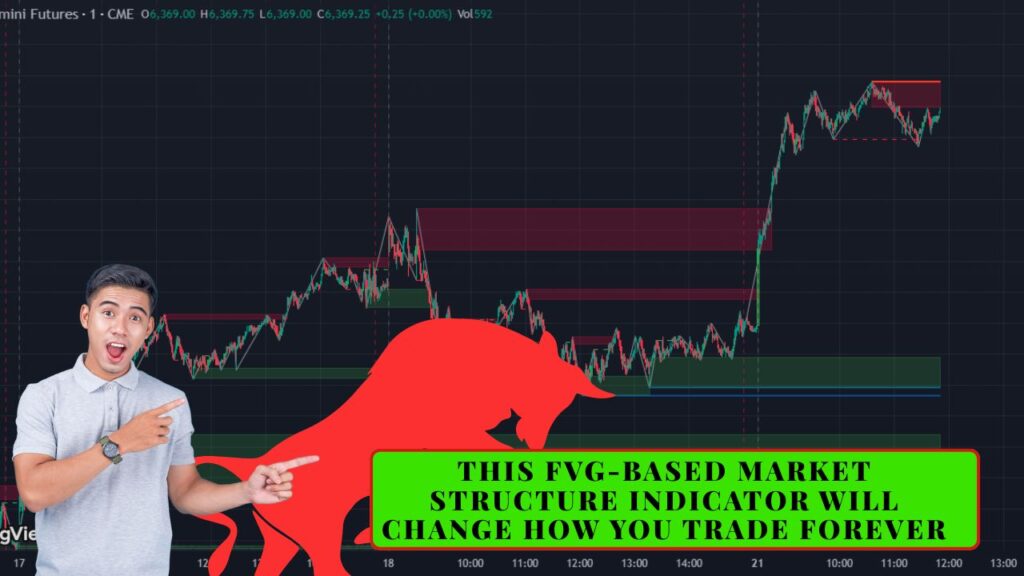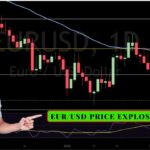If you’re a trader who’s ever felt frustrated by traditional market structure indicators — the kind that miss moves, lag entries, or confuse you with static thresholds — you’re not alone. The good news? There’s a smarter, more reactive way to read the markets.
Welcome to the FVG-Based Market Structure and AOI Indicator — a next-generation tool that redefines how traders identify swing points, market structure breaks, and areas of support and resistance. Instead of relying on arbitrary parameters like “zig-zag lengths” or fixed bar counts, this indicator leverages the power of Fair Value Gaps (FVGs) to bring clarity, precision, and objectivity to your charts.
In this article, we’ll explore what makes this indicator unique, how it works, and why traders are calling it a game-changer for modern price action analysis.
What Makes This Indicator Different?
Traditional structure tools rely on lengths, percentages, or bar counts to define swing highs and lows. These settings are often too rigid, and worse — they lag behind price, making your analysis reactive instead of proactive.
This new approach removes all of that guesswork.
The core idea? Let the market define the structure itself, based on where real buying and selling occurred. The indicator uses Fair Value Gaps (FVGs) to create a rule-based, real-time view of market structure and areas of interest (AOIs), giving you a clearer understanding of who’s in control — buyers or sellers.
Understanding FVGs: The DNA of Price Imbalance
Fair Value Gaps are created when price moves aggressively in one direction, leaving behind an imbalance between buyers and sellers. These gaps are often filled later, making them high-probability zones for re-entry, reversals, or continuation plays.
In this indicator, FVGs are used to:
- Define new swing highs/lows based on real-time reactions.
- Determine market direction by identifying the first FVG that opposes the previous trend.
- Eliminate lag and remove dependence on arbitrary length settings.
Rather than waiting for a set number of bars to pass or for a retracement to occur, the indicator reads the first FVG in the opposite direction as a sign of a potential shift — offering you a timely signal to adjust your strategy.
Market Structure Without the Noise
This FVG-based structure method gives you:
- True swing points, not estimates.
- Real market reactions, not statistical assumptions.
- A structure system that adapts to market pace, whether trending or consolidating.
And here’s the best part — the structure won’t form if the market doesn’t justify it. For example, in a strong uptrend with no retracements, the tool won’t force unnecessary swing points just to fit a template.
AOIs: Real Zones That Actually Matter
The indicator doesn’t just show where price has been — it shows where it matters.
AOIs (Areas of Interest) are formed using a cause-and-effect relationship:
- Cause: A swing low with strong buying.
- Effect: An FVG forms, followed by a structure break.
These AOIs are drawn from the swing point to the bottom of the FVG, providing zones where institutional traders likely entered. When price returns to these areas, the reaction — or lack thereof — tells you everything you need to know about current momentum.
Whether you’re a supply and demand trader, smart money trader, or a structure-based scalper, these zones give you an edge.
Reflection Lines: Visual Clarity at Key Levels
Reflection Lines are an elegant addition to this tool. These lines:
- Act as visual reminders of past support/resistance pivots.
- Extend beyond the mitigation of the AOI for ongoing reference.
- Change color based on price’s position (above or below), offering quick sentiment at a glance.
They’re simple, logical, and hugely effective for spotting flips and retests.
Session Lines for Contextual Clarity
To enhance post-trade review or analysis, the indicator also includes session start and end lines (default: NYSE). These lines are helpful for:
- Analyzing volume and structure in specific trading sessions.
- Backtesting strategies with time-sensitive setups.
- Building a repeatable, session-based trading plan.
Everything is adjustable — including timezone and session hours — for complete customization.
Volume Integration: Know Where Big Players Stepped In
Another standout feature is the optional volume readout inside each AOI. This shows the accumulated volume from the swing point until the FVG closes, which can be crucial in spotting institutional activity.
Since an FVG is a 3-bar formation, and volume drives imbalance, this information is a powerful confirmation signal that a zone was driven by real participation.
Why This Indicator Works
No guesswork — It’s rule-based and reactive
Volume-aware — Know if buyers/sellers had real conviction
Structure-only when needed — Avoid over-complicating clean trends
Visually clean — With optional session markers and reflection lines
Customizable AOIs — Tailored for smart money traders
This indicator doesn’t try to predict the market — it reacts to what actually happens. That’s the key difference.
Final Thoughts: The Smart Way to Trade Structure
If you’re tired of structure tools that draw messy swings, react too late, or offer no real insight, this FVG-based approach may be the last tool you ever need.
By focusing on price reaction, not arbitrary metrics, and combining that with AOIs, volume readouts, and smart visual cues, you’re getting a professional-grade indicator that’s built for real-world trading.
Whether you’re trading crypto, forex, or futures — this tool can help you see the true story behind price action.
Ready to trade with clarity, confidence, and control? Try the FVG Market Structure Indicator today and see the difference for yourself.
Disclaimer
This content is for educational and informational purposes only and should not be considered financial advice. Trading involves risk and may not be suitable for all investors. Always do your own research or consult with a licensed financial advisor before making any trading decisions. The indicator discussed is a tool to assist analysis and does not guarantee any specific results.
Conclusion
The FVG Market Structure Indicator redefines how traders analyze price action by eliminating lagging swing-point methods and introducing a logical, rule-based structure powered by Fair Value Gaps. Unlike traditional tools that rely on fixed percentages or lookback lengths, this indicator listens to the market — reacting to real-time imbalances and clean structure shifts. By combining Fair Value Gaps with Market Structure Breaks and identifying key Areas of Interest (AOIs), traders can spot genuine demand and supply zones with better accuracy. If you’re tired of missing entries or relying on hindsight-based signals, this tool offers a fresh and more efficient way to track directional bias, reversal zones, and potential breakout moves — all in real time.
FAQs
1. What is the FVG Market Structure Indicator?
The FVG Market Structure Indicator is a trading tool that uses Fair Value Gaps (FVGs) and Market Structure Breaks to identify directional bias and key support/resistance zones. Unlike traditional ZigZag or swing-point indicators, it reacts to real market imbalances rather than fixed parameters.
2. How does the indicator identify support and resistance?
It defines “Areas of Interest” (AOIs) by analyzing cause-and-effect relationships — such as aggressive buying/selling followed by FVG formation and structural breaks. These AOIs act as potential zones for reversals or trend continuations.
3. Why are Fair Value Gaps (FVGs) more effective than traditional swing points?
FVGs represent true price inefficiencies where institutional buying/selling occurred. They respond to real market aggression rather than arbitrary retracement levels or bar counts, providing more timely and relevant structure shifts.
4. What makes this indicator unique from standard market structure tools?
This tool doesn’t rely on static inputs like length or percentage. It uses a rule-based system that dynamically adjusts to market flow, giving you more clarity on trends, breakouts, and zone mitigations — with no repainting or subjective guesswork.
5. Can this indicator help improve entry and exit timing?
Yes, the indicator is designed to provide early signals of potential reversals or continuations through FVG behavior and AOI interaction. Traders can use these insights for better entry precision and confirmation of trend bias.



